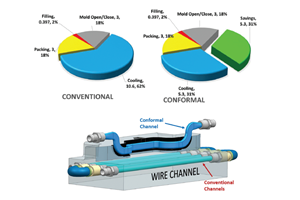Laser Welding is More Than the Machine
The right laser welding formula leads to efficient mold repair and increased tool life.
Welding is commonly used in mold repair to restore the mold to its optimal working condition. Advanced laser welding technology, coupled with experienced welding technicians and a fully equipped, on-site metallography lab, can help minimize or eliminate the negative effects of welding, increase mold life and improve the overall manufacturing process.
For example, take a simple gate repair. Gates can become worn or damaged in a number of ways, and the right repair process can return the gate to its original state, or potentially to an even better condition. Here are the key steps to an efficient gate repair:
Analyze the damage. Determine the degree of damage to the gate. Some gates develop cracks during operation. Others are damaged during startup or cycle interruption when the hot tip drips a small piece of plastic, the “cull,” into the gate. Still others may have been damaged in a previous repair process.
Inspect the defects. Use visual inspection (at as high as 24x magnification) or even dye-penetrant inspection (DPI) or fluorescent penetrant inspection (FPI) to find the source of the defects. Finding any small pits, microscopic cracking and the roots of larger cracks are all important to the restoration process. If the defects are not identified and removed, they can create more problems for the gate and the mold in the future.
Remove damaged material. Machine out the damaged and/or fatigued material. This not only removes stress, but allows the repair to be built on “virgin” steel that has not been affected by previous welds and thus restores the tool to a “like-new” condition. Once the stress and previous welds have been removed, the gate repair operation can begin.
Laser weld. Pulsed laser welding exhibits exceptionally low heat input, which offers several advantages compared to traditional tool-repair welding methods such as TIG, micro-TIG and plasma (see Figure 1). These advantages include a smaller, sometimes undetectable, heat-affected zone (HAZ); greater control of grain growth; desired hardness for as-welded repairs; wider variety of material combinations; general lack of pitting and internal defects; the potential to eliminate pre- or post-weld heat treatment; and reduced distortion or shrinkage.
This process requires a pulsed Nd:YAG laser welding system developed specifically for the tool and die industry, and experienced operators. Conventional welding processes typically require pre- and post-heat treatment to be performed correctly, but laser welding often eliminates the need for these steps, creating a better weld and significantly decreasing turnaround time.
These benefits, combined with targeted material selection and hardness matching, can result in a gate repair that surpasses what can be attained with traditional methods that match the base material and the filler. The laser welding process permits the use of a wide range of dissimilar metals, allowing selection of a filler metal that will result in optimal performance. Pulsed laser welding has an extremely low dilution rate, meaning the weld bond is better, so it allows for more adaptability that other types of welding. Laser welding can be used to combine many different materials, including P-20, beryllium copper (BeCu), stainless steel, S-7, H-13, and others. One of the most common marriages of materials is stainless steel to BeCu, which maintains the cooling properties of the BeCu while adding a better wear surface in the stainless steel (see Figure 2). For example, a 410 stainless steel filler can result in a repair with a fine martensitic microstructure, providing optimal wear performance without compromising the mold’s ability to withstand flexing during injection.
Another advantage of laser welding in mold repair is the laser’s ability to reach areas that might be out of the welder’s range when using another method. Gates are very often in hard-to-reach places or surrounded by critical features. Laser welding is highly precise and can reach the target area and avoid these features. It is a line-of-sight process—if you can see it, you can weld it—making these repairs feasible and significantly reducing rework time.
While the repair process for gates is relatively simple, laser welding can be applied to other repair challenges as well to increase tooling life well beyond its intended period, and save time and money in the process.
Related Content
How to Overcome Complex Mold Texturing Problems
Key benefits when considering laser technology for mold texturing and repair.
Read MorePortable Low-Heat, Non-Arcing Resistance Welder for Mold Repair
Rocklin’s user-friendly MoldMender Micro Welder delivers simple and cost-effective localized repair in-house with precision and versatility, enhancing mold and die durability and reducing disassembly and downtime.
Read MoreHow to Use Thermal Management to Improve Mold Cooling
A review of common mold cooling issues and possible solutions, including 3D printing applications.
Read More5 Hot Runner Tips for Moldmakers and Molders
Best practices for initial hot runner tryouts and effective preventive maintenance.
Read MoreRead Next
Reasons to Use Fiber Lasers for Mold Cleaning
Fiber lasers offer a simplicity, speed, control and portability, minimizing mold cleaning risks.
Read MoreHow to Use Continuing Education to Remain Competitive in Moldmaking
Continued training helps moldmakers make tooling decisions and properly use the latest cutting tool to efficiently machine high-quality molds.
Read MoreHow to Use Strategic Planning Tools, Data to Manage the Human Side of Business
Q&A with Marion Wells, MMT EAB member and founder of Human Asset Management.
Read More




















